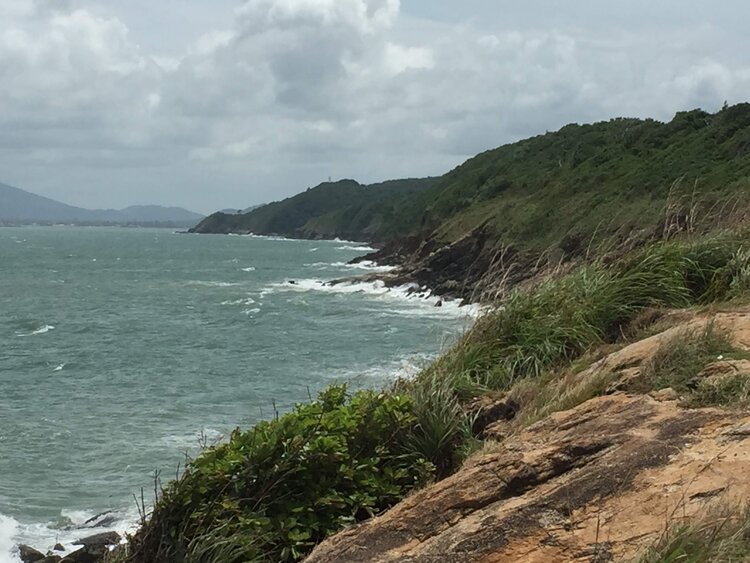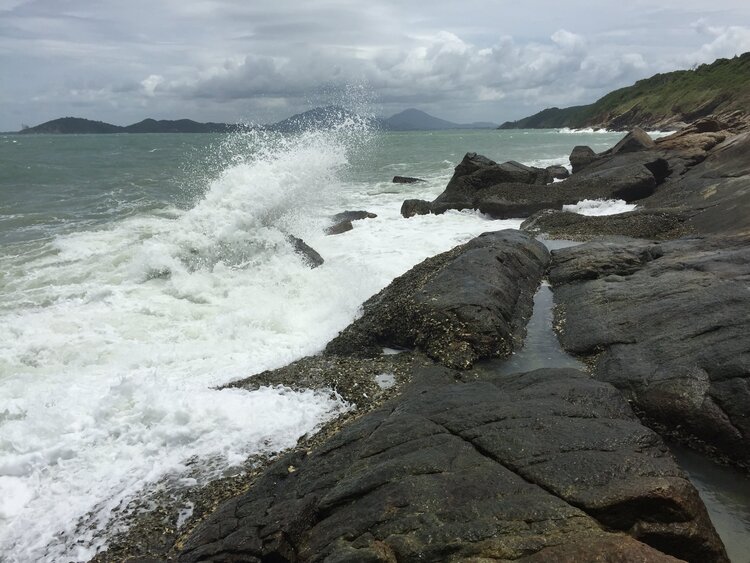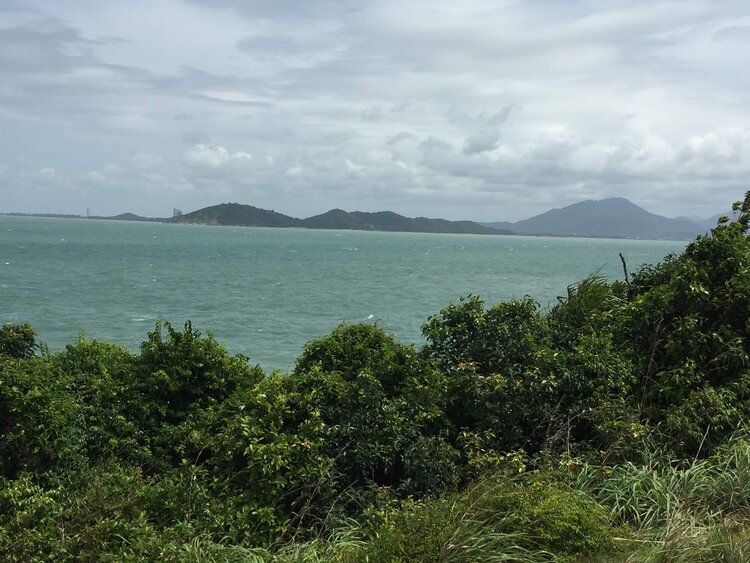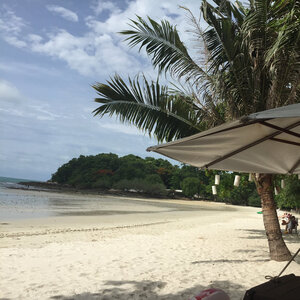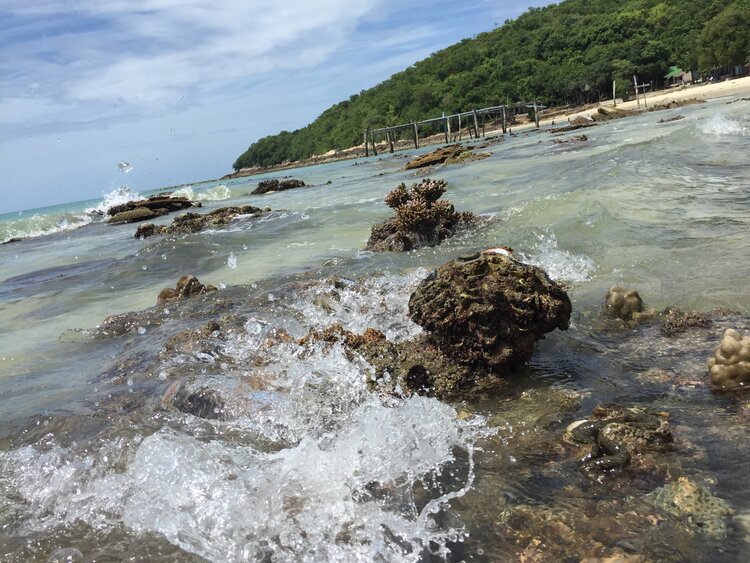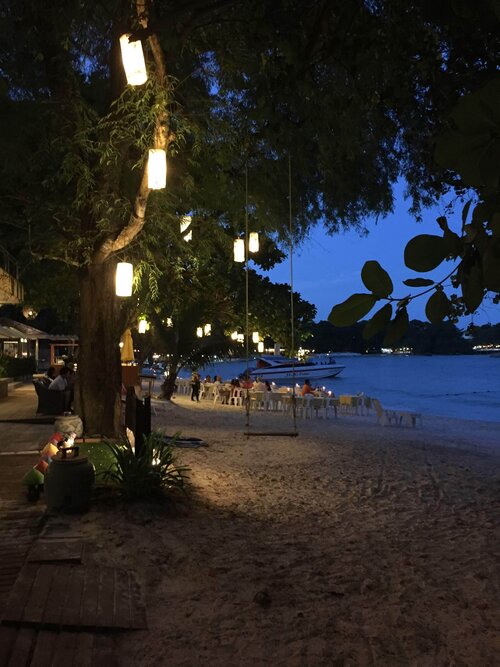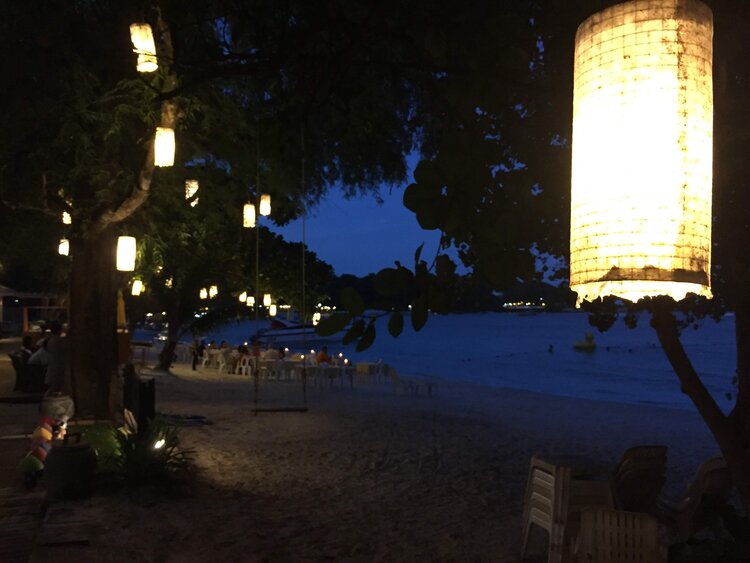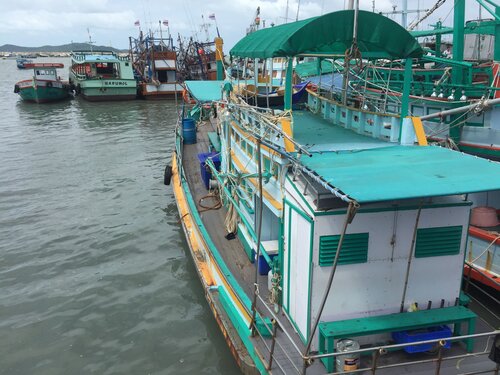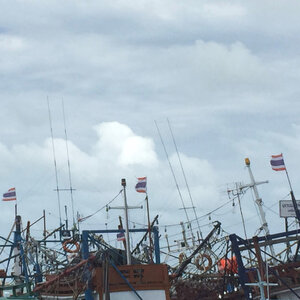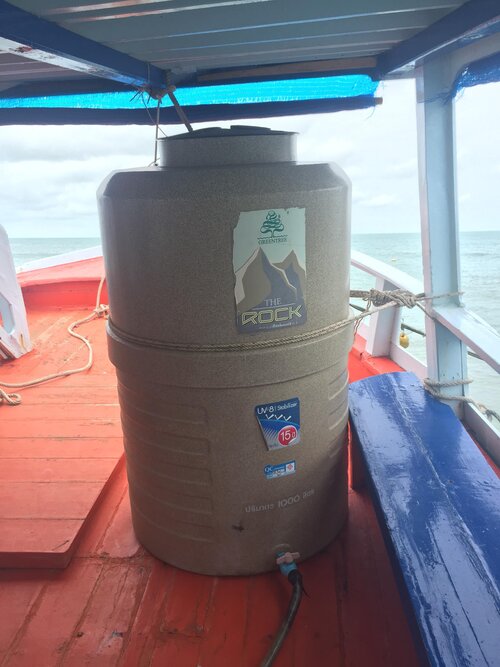Go Get Wet on Koh Samet
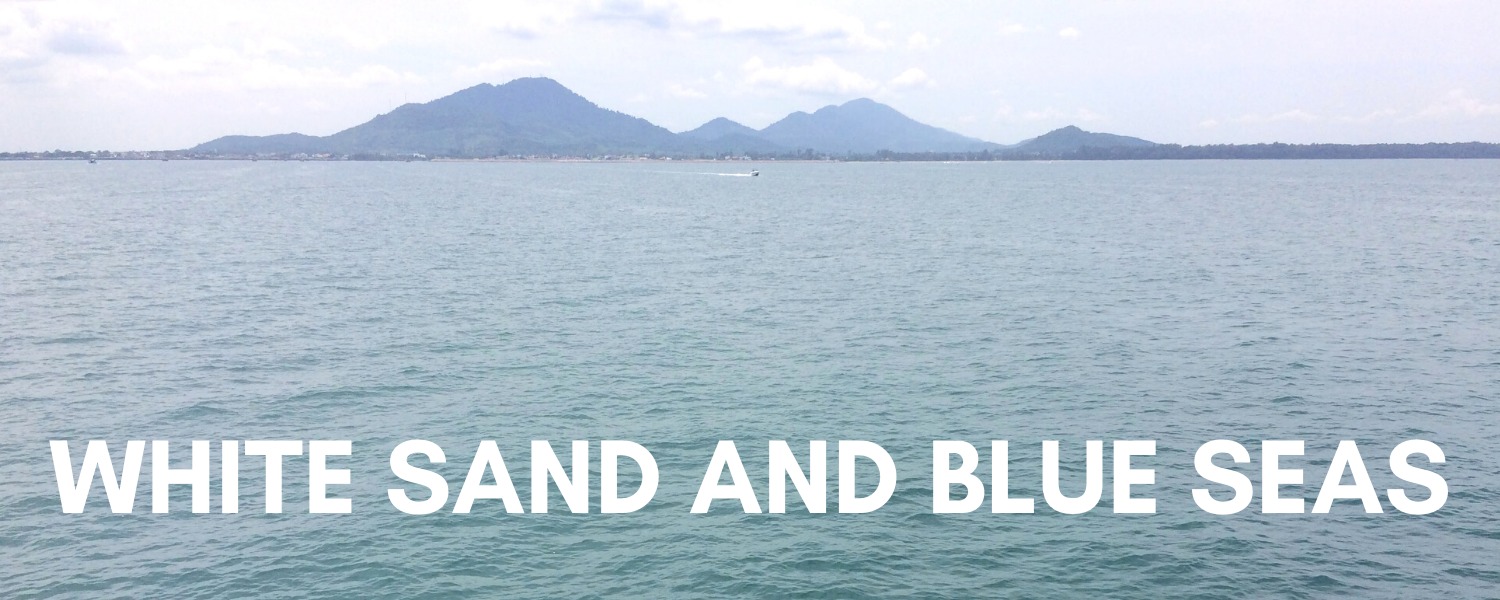
This island is shaped like a triangle and it just may be your perfect slice of tropical beach pie. White sand, blue waters, and palm trees are waiting just for you on Koh Samet.
When you’re surfing the interwebs about Koh Samet, watch-out for 2 things:
1) there is no agreed upon transliteration from Thai to English so เกาะเสม็ด becomes Koh Samet or Koh Samed or Ko Samet or Ko Samed.
2) there are 2 Koh Samets in Thailand. Both are in the Gulf of Thailand. You want the one located in Rayong Provinnce and not Chumphon Province (though if you are headed to Chumphon, we have some insights into hotels there too).
Being one of the closest islands to Bangkok, you’ll find her shores fill-up more on weekends as tourists are joined by city-dwellers looking for a seaside escape.
National Park Considerations
Most of Koh Samet (at least all the places you’ll want to go) are part of Khao Laem Ya–Mu Ko Samet National Park. You will be charged a national park entry fee upon arrival. Park rangers will be waiting for you when you step off your boat. If you haven’t already experienced it, here you’ll be introduced to #2priceThailand and dual-pricing. Thais pay 60 Baht (age 14+) and 40 Baht (ages 3 – 13) while foreigners pay 200 Baht and 100 Baht respectively. Children under 3 are free. If, like us, you are foreigners who live in Thailand, you can show your work permit and ask for the Thai price, but we’ve yet to be successful. Have cash on hand and be sure to hold onto the park entry ticket they provide.
WHERE TO STAY
When searching for a place to stay, think in bays. Koh Samet is a series of bays (Thai: Ao / อ่าว) that run down the eastern side of the island. Each bay has it’s own vibe and the further south you go, the more tranquil it becomes. The island’s public pier is on the northern edge closest to the mainland and is home to most of the action.
While on Koh Samet we suggest you put in the minimal effort to walk across to the western side. The cliffs here offer a stellar panorama over the ocean. You’ll also see how the eastern side you’re staying on is protected from the wind and waves by these western-facing cliffs.
Wong Duean Bay
Our bay of choice is Ao Wong Duean (อ่าววงเดือน). This bay puts you in the middle of the island so you can enjoy the calm but aren’t too far from the action. It’s a small bay and you can easily walk the beach end-to-end in a few minutes. There are footpaths that meander into the forest and over the hills which lead to the neighbouring bays (that’s right, there’s exploring to be done for the restless traveler while the sun-bathers lay out in the sand).
What we love the most, and by that we mean what our kids love and spend hours doing, is the sand on this bay. It’s not Maldives white, but it is close! While there we live on the beach and spend our days in the sun building sandcastles or in the shade of the many trees.
As an adult, the snorkeling is decent, but your kids will find it fascinating! Let’s set realistic expectations – this is not world class snorkeling and tourism has damaged most of the coral in this bay. You will see countless sea cucumbers, bleached corals, and enough fish to make it worth exploring.
Most people arrive in Ao Wong Duean by speedboat so prepare yourself that there are going to be boat motors revving into your serene moments.
There is a well thought through mini mart on the bay where you can grab drinks, snacks, beach gear, and crucially, ice cream!
Our Favourite Hotel on the Bay
We stay at the aptly named Vongdeuan Resort. The resort has an eclectic mix of accommodation and most are family friendly. Our room of choice is the beach house which is closest to the beach (because who doesn’t love a front porch aimed right at the ocean?!).
Vongdeuan Resort is on the beach and the hotel footpaths sprawl between pockets of different style accommodations. The beachfront trees are strung with simple paper lanterns and we’ve spent countless hours soaking it all in while swaying on the rope swings.
In the evenings, the hotel restaurant slips down onto the sand with tables and chairs lit by candles and those wonderful lanterns in the trees. Their food is the best on the bay (we’ve tried them all) and there is something whimsical about your toes in the sand while you eat.
Other reasons that we love the Vongdeuan include the investments they keep making in their property. They updated the pool deck area last year and the grounds team is constantly at work. They also have their own ferry and the cost is included in your stay. It can take up to an hour and so you may want to consider a speedboat (see below). At the mainland pier, Vongdeuan Resort has their own building to the left of the main pier building. Their staff will help you from the moment you arrive at their pier office.
Ao Wong Duean has a number of other hotel options with some very different vibes. While we think we’ve found the best fit for our family, you may be looking for something for couples or a more slick vibe. This bay has that too.
WHEN TO GO
Locals gush about Koh Samet’s micro-climate and how it is the driest island in Thailand. Don’t go thinking desert – rather imagine a more merciful rainy season. From May to August, you will the island in the midst of rainy season. By September it is turning around and October through to December is prime time on Koh Samet.
HOW TO GET THERE
Ban Phe Piers on the mainland
Boats to Koh Samet leave from Ban Phe (pronounced “Ban Pay”). This once tiny fishing village has grown into a transport hub with multiple piers. Located about 220 kms from Suvarnabhumi Airport (BKK), Ban Phe is now awash with shops and 7-Elevens. So if you feel like you’re headed the wrong way through small town Thailand, then you’re on the right track.
The two main piers are Nuan Thip Pier and Ban Phe Municipal Pier. The Vongdeuan Ferry leaves from the Ban Phe Pier. There are smaller piers operated by private speedboat companies.
Parking is available at the main piers and the cost is 50 baht / day. Just pull in and look for a parking attendant. They’ll help you find a spot and get your receipt.
Getting to Ban Phe
Coach buses to Ban Phe depart from Bangkok’s Ekkamai (eastern) bus station. You can also book a seat on a minibus (think van) from either Ekkamai or Mo Chit (northern). Both of these bus stations are along the BTS Skytrain system.
Private car transfers are available and we’ve done this with our kiddos. We’ve even jumped in a taxi to go to Mo Chit Bus Station and instead ended up paying the taxi driver to take us directly to the pier in Ban Phe (probably best to speak a little Thai before doing this one). You can also drive yourself.
However you get there, be sure you know which pier you are going to. Not all buses or minivans end at the same pier and if you tell your driver “Ban Phe” they may be thinking of a different pier than the one you intended.
Booking Your Crossing
The smaller piers usually only have a few speedboat companies operating from them. Most travelers will have pre-booked a ticket before arriving at these smaller piers. If you arrive at one of these but are looking for a public ferry, don’t expect much help. It’s not good for business to send potential customers to the ferry.
The two main piers have open air structure which house a number of booths and kiosks with different speedboat companies. Some will have agents waiting in the parking lot offering to help with bags or sell you tickets right there.
It’s fast moving and high-pressure. Stay calm. Explore your options. Be sure to negotiate. A speedboat will have you on the island in 15 – 20 minutes and should cost around 1,200 to 1,500 Baht for your group (a boat full). There are public ferries (Thai-style wooden boats) which leave from Nuan Thip Pier. These coast 70 – 100 Baht one way. All ferries sail to Na Dan Pier on Koh Samet.
There are some unscrupulous operators here who will tell you that you must book a return ticket, or you must have a hotel booked before going to the island, or that you must pay the national park fee there. None of this is true.
Arriving on Koh Samet
The main pier is Na Dan Pier. If you land here, there is a 20 Baht Pier Fee. Na Dan, also called Koh Samet Village, will welcome you with ATMs, 7-Eleven, and small shops. If you need to stock-up, do it here. Just south of town is Hat Sai Kaew (Glass Sand Beach) which lives up to it’s name with stretches of white sand.
Na Dan is not inside the national park, so you won’t pay the park entry fee until you leave town via a checkpoint. At the pier numerous songthaews (pick-up trucks with 2 benches in the back) will be vying for your business to transport you to your hotel (if your hotel does not provide a transfer).
Many of the speedboat companies will take you directly to your hotel – be sure to check before you buy. Few ao’s on Koh Samet have piers so the speedboats will throw it in reverse, haul their motors out of the water, and all but beach themselves. Wear shorts or a skirt that you can hike-up as you hop off the back of the boat and into the shallows.
The Vongdeuan Ferry will pull into the bay and a smaller boat will come to meet you. There is a floating pier that will test your balance and agility!
GETTING AROUND
Your hotel can hail a songthaew for you and most often will help you with the prices. You can also ask your accommodations to book a boat which can sail you from one bay to another. If you get tired of waiting for a songthaew, you can jump a boat instead. Scooter rentals are plentiful on Koh Samet and rental thresholds are low. Expect to see well-meaning but inexperienced tourists scooting along. We’ve had friends wipe-out while exploring Koh Samet by scooter so please do insist on helmets.
TIPS
Prices are higher as everything has to be brought from the mainland. You can save some coin by bringing snacks and drinks with you.
2 words: BUG SPRAY. Mosquitoes also enjoy Koh Samet so be sure to come armed with your repellent of choice.
Fresh water in the taps is still not drinkable, but it is precious on Koh Samet. With no desalinated water sources on the island, hotels have to bring over fresh water to use for showers, baths, toilets, and dish washing. You’ll see boats with water tanks pumping water to the hotels through long tubes across the beach. Do your best to conserve water while on the island.

